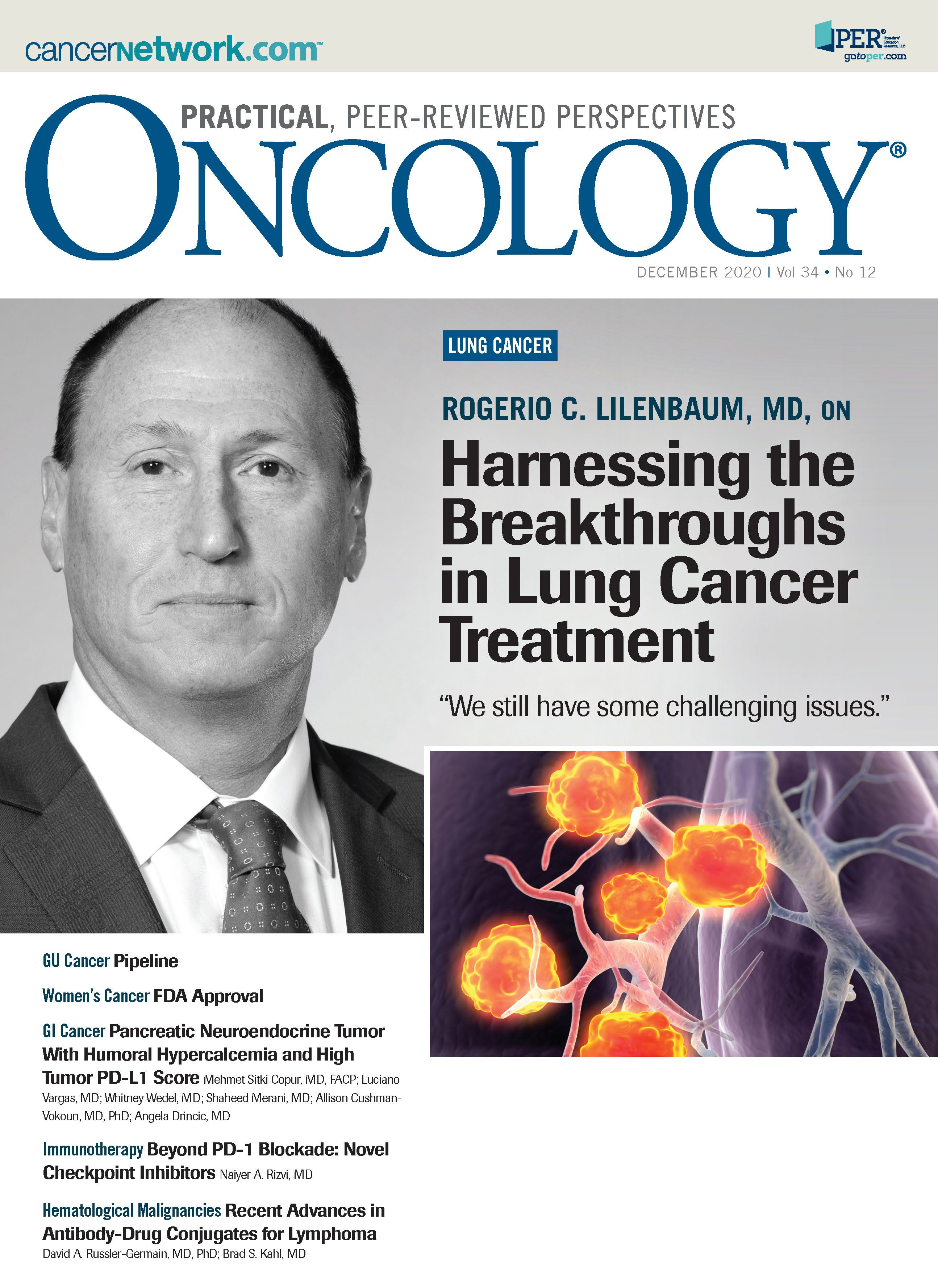Harnessing the Breakthroughs in Lung Cancer Treatment
ONCOLOGY® recently sat down with Rogerio C. Lilenbaum, MD, director of Banner MD Anderson Cancer Center, to discuss current and future trends in the care of patients with lung cancer, as well as his transition from clinician to administrator and the considerable set of challenges that role brings.
Lilenbaum is Director, Banner MD Anderson Cancer Center

Lung cancer incidence and mortality in the United States have been on the decline, due in large part to a sharp reduction in tobacco use.1 Results of a recent study have brought additional good news: For patients with non–small cell lung cancer (NSCLC), mortality is decreasing faster than incidence,2 suggesting that the recent rise in the use of targeted therapies is having a very significant impact on overall survival.
But work still needs to be done. While mutational targets have been identified, and newer therapeutics have been approved, optimizing that targeted therapy and sequencing every patient in order to treat them in accordance with current guidelines and algorithms remains a challenge.
ONCOLOGY® recently sat down with Rogerio C. Lilenbaum, MD, director of Banner MD Anderson Cancer Center, to discuss current and future trends in the care of patients with lung cancer, as well as his transition from clinician to administrator and the considerable set of challenges that role brings.
Q: Can we look forward to any trends or developments for patients with lung cancer?
LILENBAUM: I think we still have some challenging issues. We’ve been on the edge of identifying an agent for KRAS-mutated tumors; KRAS happens to be the most common mutation in lung cancer. I think that’s exciting. So far it hasn’t been actionable in the sense that we have an agent to target that mutation. But now new agents are out there showing promising activity in KRAS-mutated tumors. And then in immunotherapy, other agents that are not checkpoint inhibitors have other targets within the activation of the immune system. I think those agents are promising, and then you can take that concept of immune manipulation and take it all the way to even chimeric antigen receptor T cells, which we now use for leukemias and lymphomas. There are some promising early data showing that this approach may have some efficacy in solid tumors as well.
Also, when we talk about targeted agents, an aspect of this conversation that has always interested me, and at times baffled me, is how some data are quickly adopted and applied by the majority of practicing oncologists, and then other data sets that [also] appear to show significant benefit are not as widely adopted. In stage 3 disease, for example, we have unequivocal data that one checkpoint inhibitor, durvalumab (Imfinzi), at least as of now, improves outcomes. And yet, to the best of my knowledge, utilization of that strategy is not as high as it should be. Granted, the management of stage 2B patients is complicated, and not everyone follows the [same] paradigm: In order [for a patient] to get to the durvalumab [treatment], you have to have received concomitant chemo and radiation, and not everybody does. [Yet,] it surprises me at times that powerful data like this are still not applied more widely, as they should be.
Q: You are a cochair for the 18th Annual Winter Lung Conference®. What can we look forward to during that meeting, and what makes the meeting so beneficial for oncologists?
LILENBAUM: I think one benefit of attending Winter Lung is the opportunity to hear about the most important advances in the field of lung cancer through the opinions of experts. You see the data and have an opportunity to understand the most impactful trials and studies that have been done in the recent past. And then on top of that, you have an opportunity to get editorial comments and personal opinions from national and international experts. That’s a hallmark of Winter Lung and it has been for quite some time.
A second benefit is that we tend to give everybody an opportunity to present a case. We have case presentations on the agenda during the meeting. So, Winter Lung becomes a very real-world conference in the sense that you’re discussing real patients in real time among experts from different disciplines. It’s both an academic exercise in the sense that you hear the latest in the interpretation of the experts, and it’s also a very clinical and practical conference in the sense that you get to apply that knowledge to patient care. And I think that balance has always characterized a Winter Lung conference.
Q: What are some of the clinical issues that will be discussed?
LILENBAUM: One question I’d like to see discussed is whether we have optimized the use of targeted therapy. We now have a set number of actionable molecular alterations. It’s not likely that we will see many new ones or new targets discovered in the near future. Are we testing everyone for all the actionable mutations? And are we treating those patients according to evidence-based algorithms and guidelines? This may seem very obvious, but it’s far from obvious in clinical practice.
I think a significant percentage of patients with NSCLC and nonsquamous histology who have potentially actionable mutations don’t always get treated as such. And I think that’s an important issue.
Q: Why is that? Why are we not optimizing the use of targeted therapy for these patients?
LILENBAUM: First, I think, is that testing in this day and age is still somewhat erratic. It’s not as pervasive or as generalized as it should be. Then, even within each category—EGFR, ALK, ROS, RET, BRAF—the information about how to best manage those patients is not always within the domain of the average oncologist. This was further complicated by the advent of immunotherapy.
A second issue is how we can identify patients who truly benefit from checkpoint inhibitors beyond just PD-L1. In some patients, the benefit of checkpoint inhibitors is nothing short of extraordinary. We’ve seen this from years of research. But in other patients, the benefit is fairly modest. Yes, PD-L1 is a marker that can help ascertain that magnitude of benefit, but it’s far from perfect. And I think we need additional predictors or predictive factors to justify the cost and the toxicity of these agents.
Those are 2 very practical, broad issues in terms of [patient] management. I think we now are beginning to see the application of these 2 strategies to early-stage disease. That would be a third point. We now have the data for osimertinib in the adjuvant setting for EGFR-positive patients. That, to me, is a breakthrough, and it will change the way we do adjuvant treatment. And I think we’re going to see similar data for other molecular alterations. More importantly, we will see data for immunotherapy in the early-stage settings. So I think, again, that how you apply the knowledge that we’ve acquired in late-stage disease to early-stage disease is among the most potentially impactful areas of research. When you [use immunotherapy] in early-stage disease, what you’re doing is not only prolonging life, but increasing the cure rate. And that’s what we want to see.
Q: When it comes to immunotherapy, the term “cure” comes up with other cancers, notably with melanoma, but not, it seems, with lung cancer. Why is that?
LILENBAUM: I have made that comment a few times. Number 1, I think we don’t have as long a follow-up in patients with lung cancer as we have in patients with melanoma. Number 2, when you get to the bottom line, it doesn’t really appear that immunotherapy in lung cancer has the same overall impact as it does in melanoma. So, I think it is harder to apply that concept of cure to advanced disease in lung cancer at this point.
Q: You’re originally from Brazil. How did you end up here in the United States?
LILENBAUM: I came purely for professional reasons. After finishing school and beginning my training, I realized I wanted to become a medical oncologist. At that time, though, Brazil had very few options for oncology training, so I came to the United States.
I enjoyed not only the practice of medicine in the United States, but the academic component and specifically the opportunity to be involved in clinical research. By the time I was finishing my fellowship, I really couldn’t see myself in any other place, and I was very fortunate to have outstanding mentors who opened a lot of doors and opportunities for me. So, I had an early entry into the world of lung cancer and lung cancer investigation and research.
Q: What was going on at that point that attracted you to the field?
LILENBAUM: This was the mid-1990s. We had a huge influx of new chemotherapy drugs in lung cancer, and this was a disease that up until the early to mid-1990s had essentially 1 or 2 regimens that had shown some efficacy, and, by the way, horrendous toxicity. The new drugs, at the time, seemed to provide greater benefit and much less toxicity. So, the benefit ratio for treating advanced patients at the time improved significantly, and there was a lot of conversation about how to utilize those new drugs. These drugs—vinorelbine and gemcitabine, just to name 2— came into life in the mid-1990s and dominated the conversation about treating advanced NSCLC, including mega-trials about what was the optimal regimen: Is there a better combination of drugs? Do you really need 2 drugs, or is 1 drug sufficient in some patients? Also: Do you really need a platinum agent? Can you do a nonplatinum combination? How do you treat elderly patients or patients with a performance status of 2? Those were questions that dominated the conversation, I would say from 1995 to 2005, when we started to steer more in the direction of targeted therapy, and that’s where I cut my teeth in lung cancer.
Q: Along your career path, you transitioned into a more administrative position. What took you there?
LILENBAUM: I felt that after about 12 or 15 years of a very active clinical practice, plus a very active clinical research career, I wanted to have a different impact on how cancer care is delivered—to take this experience into organizations that were creating comprehensive and integrated cancer care delivery systems. That was my impetus. It has been, to some extent, a long journey. It is, in many ways, much more challenging than clinical care or clinical research, but no less important.
Q: Can you talk about some of those challenges?
LILENBAUM: Well, first, physicians in my generation were not trained in, and did not necessarily graduate from fellowship with, organization skills or leadership skills. If anything, we were trained to acquire a certain body of knowledge and make decisions independently on behalf of the individual who is in front of you and happens to be a patient at the time. Then [as an administrator] you take that experience, or even the experience of research, which applies to a larger population, but [these people] are mostly invisible to you. Then you think about, How do we do this at a larger scale, in a way that is more structural and less individual, that is more foundational? Above all, [how do we do it] in a way that sets a culture for high-quality service to patients? That’s why I decided to do this. And I had the opportunity when I was recruited to be the chief medical officer for the Yale Cancer Center and the Yale Cancer Hospital, and I worked with some of the best people in the country in every aspect of cancer care and was exposed to a tremendous amount of information and knowledge that I did not acquire formally. I don’t have an MBA, for example, as some [colleagues of mine] do. I also had the opportunity—or the responsibility, I guess—to implement changes that would change how we delivered care across, in that case, the whole state of Connecticut. I was exposed to terrific leaders, people who had already successfully done that. So, it was a terrific experience for me, and—just to “close the loop” here—I felt, when I was approached to consider this position at Banner MD Anderson, that I was prepared to lead an entire cancer program in that direction. I wanted to take on a program that was poised to take a qualitative step toward excellence, and patient centeredness, and an integrated delivery system, and that’s why I moved to Phoenix, Arizona.
Q: What exactly do you mean by patient-centered and integrated delivery?
LILENBAUM: When people talk about “patient experience,” the automatic reflex is to think about welcoming patients or being nice to patients. That’s really only the floor, the minimum required for anyone to interact with patients at any point in time. Patience experience is really the totality of the experience of these individuals, like you and me, or loved ones, who, at that moment, are afflicted with a very serious illness and are very vulnerable and dependent on people who can provide knowledge and support to guide them through that process. So, it’s about the clinical piece and it’s about the operational piece, which is something we focus on quite a bit. It’s also about the financial piece and the cultural piece. [Unfortunately,] we don’t think of access as being a patient-centered exercise, but instead as a business opportunity. If you see patients quickly, they’ll come to you, as opposed to having to wait a week or 2. Yet at the end of the day, it really is unconscionable to keep someone who was just given a diagnosis of cancer waiting for weeks to see a physician, just to obtain a basic understanding of what their illness is. And that’s a humanistic component. It’s not about market share. It’s just the way we all [should] expect to be treated under these circumstances.
Another piece that we physicians often are disconnected from is, I think, the financial piece— having an organized financial picture of what going through cancer treatment means for the patient and their family’s well-being. Having an orderly way to manage bills, and having a way to pay for those bills, is all related to patient-centered care, and it’s a huge onus that we impose on our patients and their families. We don’t really have very a good structure to support them through that process.
Now in terms of integrated care, what we talk about here is a signature care for Banner MD Anderson. It’s that sense that if you have, say, breast cancer, you will enter the Banner MD Anderson facility and you will have the same experience as another patient with breast cancer who enters a different MD Anderson facility in a different state. It’s what characterizes what we, as a cancer program, have to offer our patients in terms of clinical excellence, operational excellence, and in strong and compassionate support throughout that experience. And to create that alignment, to create that sense that it’s all one package, is a pretty challenging goal from an administrative and financial perspective.ν
Financial Disclosure: The authors have no significant financial interest in or other relationship with the manufacturer of any product or provider of any service mentioned in this article.
REFERENCES
1. Cancer stat facts: lung and bronchus cancer. National Cancer Institute: Surveillance, Epidemiology, and End Results Program. Accessed November 9, 2020. https://seer.cancer.gov/statfacts/html/lungb.html
2. Howlader N, Forjaz G, Mooradian MJ, et al. The effect of advances in lung-cancer treatment on population mortality. N Engl J Med. 2020;383(7):640-649. doi:10.1056/NEJMoa1916623

Newsletter
Stay up to date on recent advances in the multidisciplinary approach to cancer.
